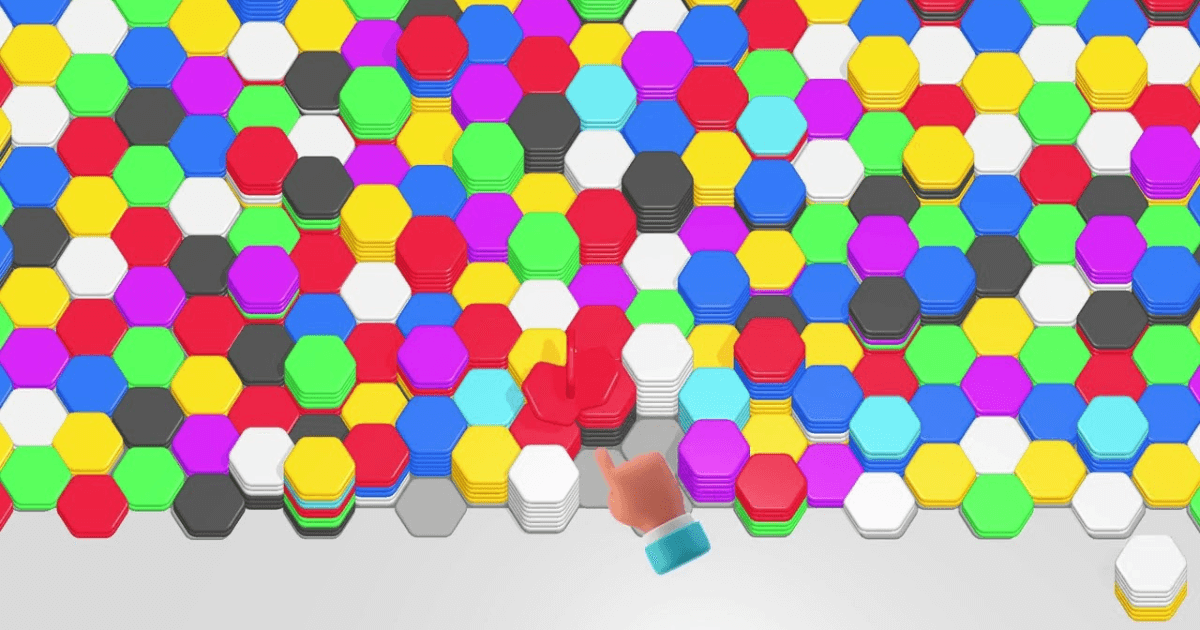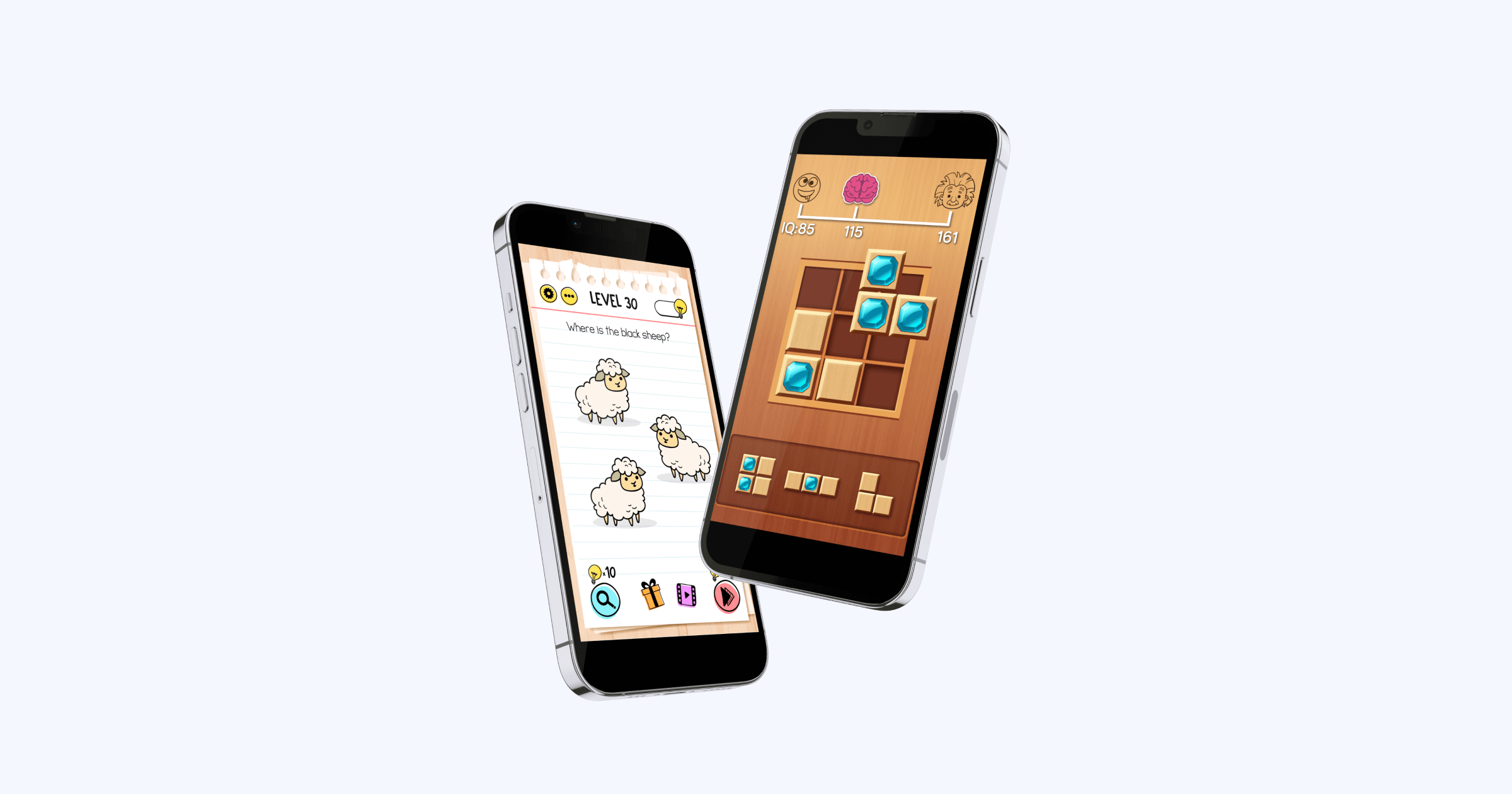As hyper-casual games are going down, hybrid-casual games are reaching new heights.
One of them is Burger Please!, a game that garnered 5 million worldwide downloads in just two weeks after its release.
How did this game become a major success? What did its development process look like? How does the game acquire and monetize players?
Look no further, we’ve got you covered.
About Burger Please!
Burger Please! is a game that simulates a burger shop. In it, players get the chance to run their own burger chain, managing every aspect of it – from staffing to expansion.
The goal of the game?
Growing a burger shop into a thriving franchise and spreading it across the map.
Burger Please! was developed by Molip and published by Supercent. This is not their first joint hit – prior to this game, these two studios collaborated on several successful titles such as Coffee Break and Donut Inc.
How the Game Was Born
In 2022, we witnessed a meteoric rise of arcade idle games.
Because of this, the developers behind Burger Please! decided they wanted to develop a game in this subgenre. Aside from gameplay, they needed to agree on another equally important aspect – the game’s theme.
The choice fell on burgers.
Why, you ask?
It’s super simple yet remarkably effective. Burgers hold a special place in our collective consciousness, evoking familiarity and positive emotions in most people.
As a result, the developers agreed on the concept of a burger shop that should attract a broad user base and deliver a unique gameplay experience.
The Challenge
The problem with the burger theme?
Since it’s so familiar, it is already used by quite a few games out there.
For this reason, it was vital to differentiate and show users what this game brings to the table that others don’t. To set themselves apart, Supercent focused on user acquisition and creating captivating gameplay videos. We’ll go over this in more detail later in the text, so make sure to keep reading.
Burger Please! Numbers
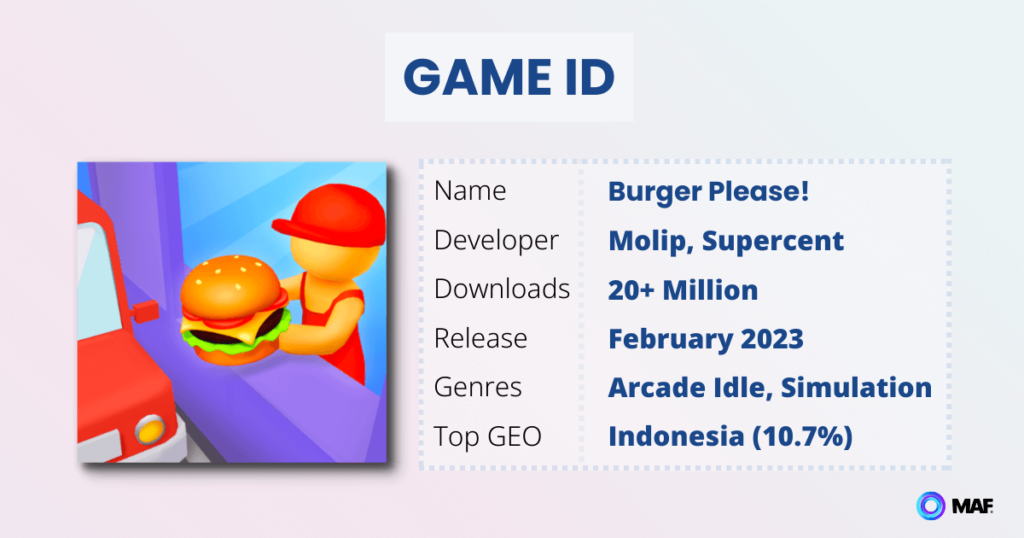
The reason we’re talking about this game today is not just its quality, gameplay, or theme.
It’s because it achieved superb results and rapidly climbed the top charts.
Here come the exact numbers.
KPIs
We rarely get an inside scoop into top games’ KPIs.
Luckily for us, Supercent has made this information public, providing us with a clear picture of the game’s path to success. They shared data from various stages, from prototyping to post-launch results.
The first test the game had to pass was the initial marketability test, where it achieved:
- $0.41 CPI
- 44% Day 1 Retention
- 1700 seconds Day 0 Playtime
These results were not ideal, but they were within the desired range, and that was enough to indicate that the game has market potential.
To optimize the game’s metrics, the developers tirelessly worked on different aspects of the game – ad creatives, in-game content, monetization updates, etc. After one month of refinement, Burger Please! was globally launched, and the results were impressive:
- $0.29 CPI
- 50% Day 1 Retention
- 2014 seconds Day 0 Playtime
Downloads & Top GEOs
As soon as it was launched, Burger Please! topped the charts.
Following its global release in February 2023, the game received 5 million downloads in two weeks, and within a month, that number doubled to 10 million downloads.
It didn’t stop there.
The game has only been out for three months, and during this short lifetime, it already received 20 million worldwide downloads (AppMagic).
Burger Please! has captured the hearts of players around the world. According to Sensor Tower, the game’s download hotspot is Indonesia, driving 10.7% of the total downloads. It is followed by Brazil (8.2%), India (7.8%), and the United States (4.7%).
Now, let’s talk money.
In just two months following its global release, the game earned $90 thousand from in-app purchases (Sensor Tower). Note that these numbers only represent a fraction of the game’s revenue. We’re currently missing the details on ad revenue, which is the game’s main moneymaker.
Burger Please: In-Depth Analysis
Now that we’ve established the reasons why Burger Please! deserves your attention, let’s dive deeper into its key aspects.
Mechanics & Genres

Burger Please! is easy to pick up and play. The main thing players have to master is moving around using joystick controls – and it’s as simple as it gets.
However, judging by its design and gameplay mechanics, the game falls into two popular genres – simulation and arcade idle.
As a simulation game, Burger Please! aims to replicate the real-world experience of managing a burger shop.
Just like most arcade idle games, Burger Please! relies on the stacking mechanic. In the game, players spend most of their time picking things up (burgers, trash), stacking them, and strategically moving from one place to another.
Progression
One of the reasons this game achieves great retention rates is its progression system. The game ensures that players are consistently occupied with goals to strive for.
As players advance through the game, they can constantly upgrade their skills and resources. For example, increase the number of burgers they can stack, hire additional workers, upgrade shop inventory, etc.
Beyond these “everyday” goals, the game also provides players with long-term objectives. If they do a good job managing their shops, they can expand their burger empire across the map, one shop at a time.
Special Features
How can you add complexity and strategy to what is essentially a simple game?
Include some special features.
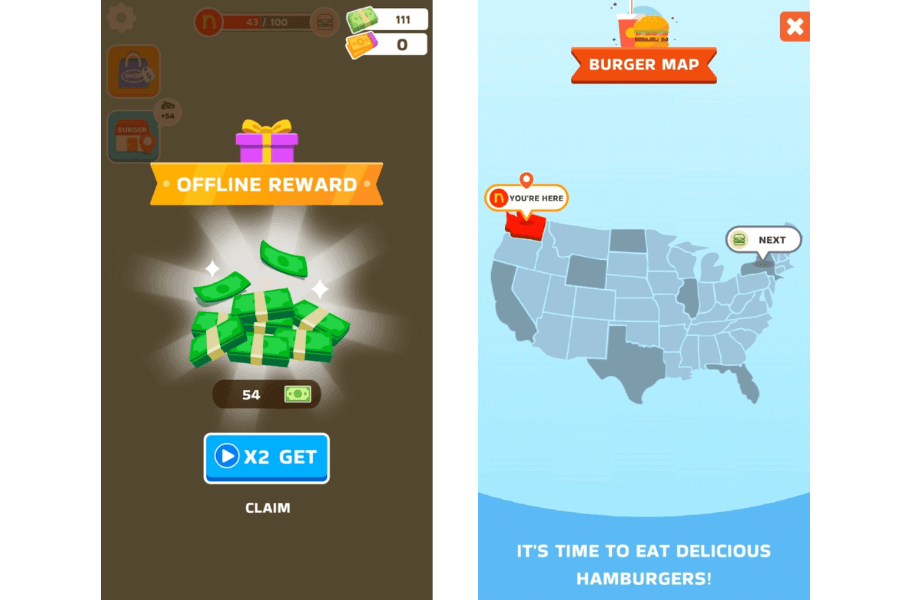
Burger Please! has a number of features, each of which works in its own unique way to keep players engaged for longer:
- Offline rewards make players come back to the game to reap rewards
- Map feature helps players visualize their progression and motivates them to expand their business
- Merchandising system that includes non-burger items, preventing the game from becoming repetitive
McTheme
When someone says burger shop, what is the first thing that crosses your mind?
If it’s McDonald’s, you’re not alone.
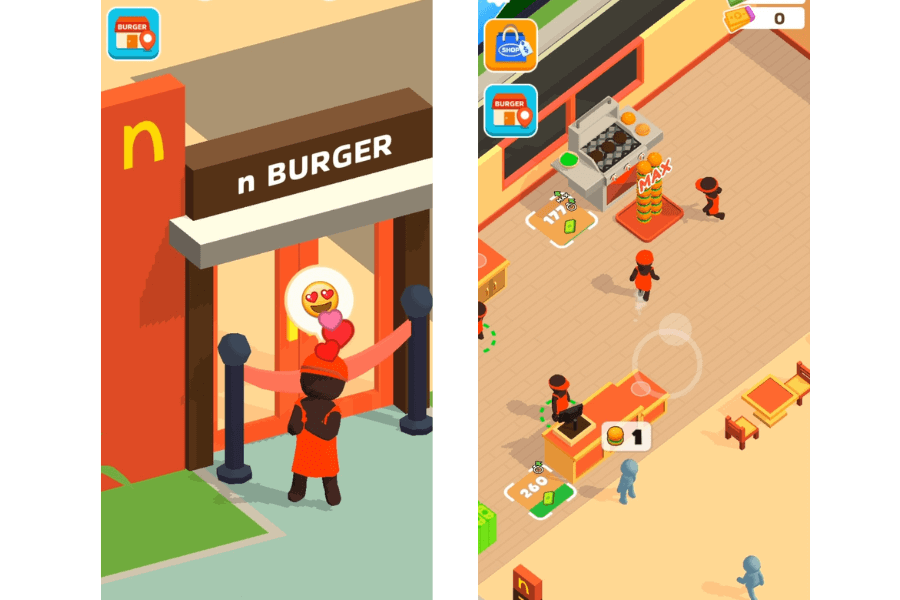
The developers of Burger Please! have cleverly capitalized on the association people have with this iconic fast-food chain by incorporating various McDonald’s-like features into the game. These intentional similarities include:
- The restaurant’s logo
- Color scheme
- The workers’ uniforms
- A drive-through feature
By incorporating these McDonald’s-inspired elements, Burger Please! taps into the appeal of familiarity and positive associations. Overall, it is a clever strategy for sparking interest and creating a relatable gameplay experience.
Monetization
Like most arcade idle games, Burger Please! makes a living through hybrid monetization. In other words, it contains a mix of in-game ads and in-app purchases.
Let’s see how they blend together.
In-Game Ads
Like most arcade idle gameas, Burger Please! faces many negative app store reviews about “too many ads”.
This, of course, refers to interstitial ads.
The first interstitial ad in the game appears after roughly 4 minutes of gameplay. Over time, the space between them gradually decreases to approximately one minute.
This game doesn’t have natural gameplay breaks like levels or stages. For this reason, the ads are announced with a small 3-second timer that a lot of players don’t even notice, so the ads may feel sudden.
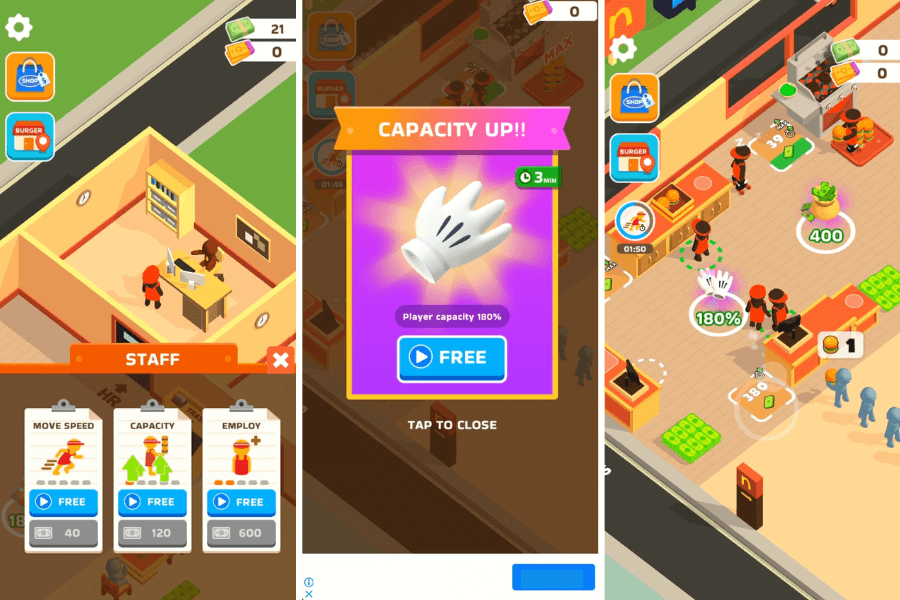
Unlike interstitials, rewarded video ads are well-accepted by players. In this game, they help players upgrade without having to pay for anything. For example, by watching them, players can hire more staff, speed up or increase their profits.
On top of this, the game also serves banner ads at the bottom of the gameplay screen. According to Supercent, banners helped them extend playtime without interfering with the gameplay experience.
In-App Purchases
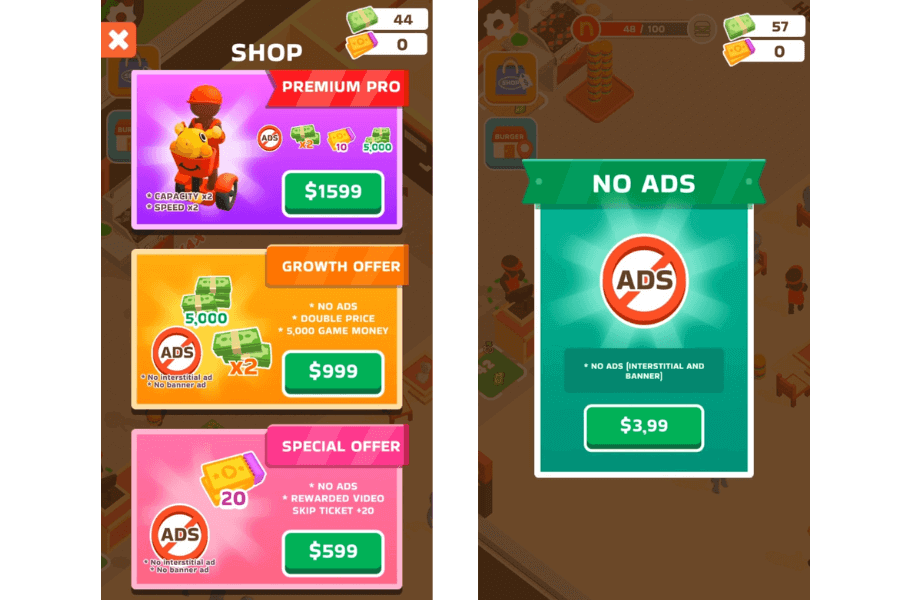
In the game’s shop, players can’t find typical currency offerings. Instead, they can choose between three bundle offers.
The game also has a “no ads” offer that pops up almost every time after players watch an interstitial ad. This is done so that if players get annoyed by ads, seeing the offer might encourage them to make an impulse purchase.
The good: The timing of the “no ads” offer.
The not-so-good: The price points in the game’s shop aren’t localized and only show the price in USD. Also, they lack punctuation. For example, a $9.99 offer is displayed as $999.
User Acquisition
Wondering how Supercent’s creative team managed to reduce the game’s initial CPI by a whopping 30%?
Let’s unveil the UA strategy behind Burger Please!.
Focusing on Gameplay Clarity
Generally, one of the best strategies for lowering CPIs is prioritizing gameplay clarity.
After only 5 seconds of watching an ad for it, viewers should understand what the game is about.
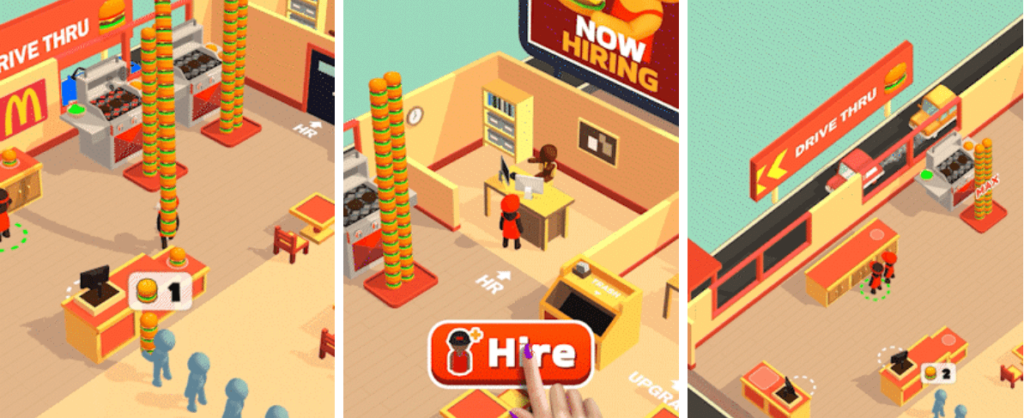
Supercent managed to achieve this with three different types of ad creatives:
- Videos highlighting the stacking mechanic
- Videos focusing on hiring and upgrading staff
- Videos emphasizing the Drive-Thru feature
All these types of creatives show how the game works, with no sugarcoating. However, because each of them emphasizes a different feature, they are able to draw in different kinds of players.
According to Supercent, videos with the Drive-Thru feature resulted in the lowest CPI ($0.39). They believe this is because the Drive-Thru is a unique feature that doesn’t appear in other similar games. As such, it helps the game stand out from the crowd and sparks the viewers’ interest.
Testing Ad Variations
In mobile ad creatives, small things can make all the difference. For this reason, Supercent’s creative team put a strong focus on testing many creative elements, such as:
- Colors
- Camera angles
- User interface
- Characters
- Environment
- Sound effects, etc.
Thanks to this thorough testing process, they were able to figure out what their target audience prefers to see in an ad.
For example, one of their main findings was that changing camera angles and zooming in on the player character improves performance. This is probably because it makes the ad more dynamic, immersing the user in the game.
McDon…I Mean Burger Please!
We already mentioned how Burger Please is filled with McDonald’s references.
Unsurprisingly, they apply the same strategy to their UA creatives.
Only here, they are not as subtle.
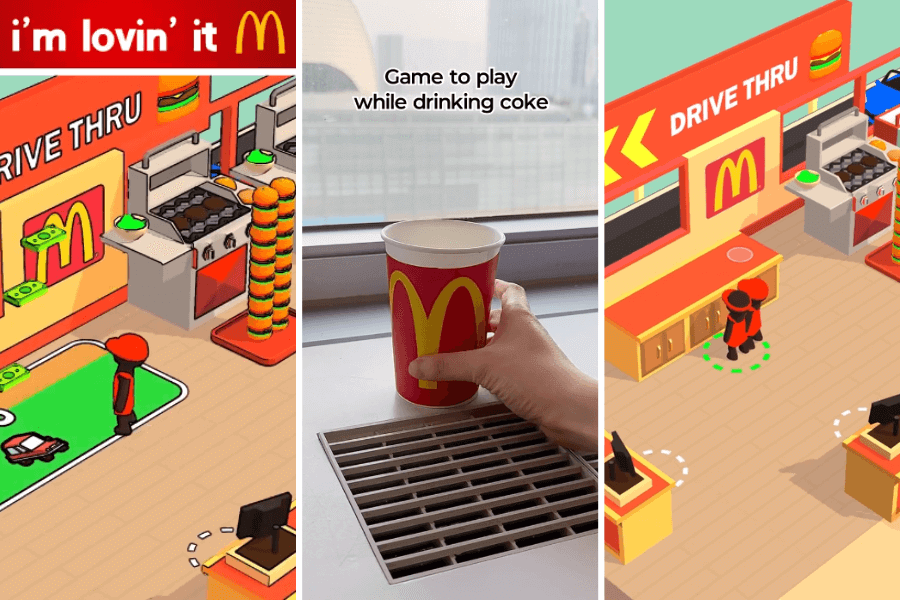
For example, instead of the “n” logo used in the game, in most of their ad creatives, Supercent uses an “m” logo, clearly mimicking the one from McDonald’s. Moreover, some of their videos feature the famous “I’m lovin’ it” motto as well as real-life footage of McDonald’s products.
The motivation behind this is similar to the one used in gameplay – by utilizing the popularity and familiarity of the McDonald’s brand, Supercent aims to draw more players to the game.
Let’s Put Our Expertise to Good Use
At MAF, we’re not only good at analyzing titles like Burger Please!.
We’re even better at helping games grow.
We’ve helped numerous apps maximize ad revenue, grow their active user bases and elevate their businesses. If you want to know more, check out our advertising and monetization solutions or get in touch with us!


